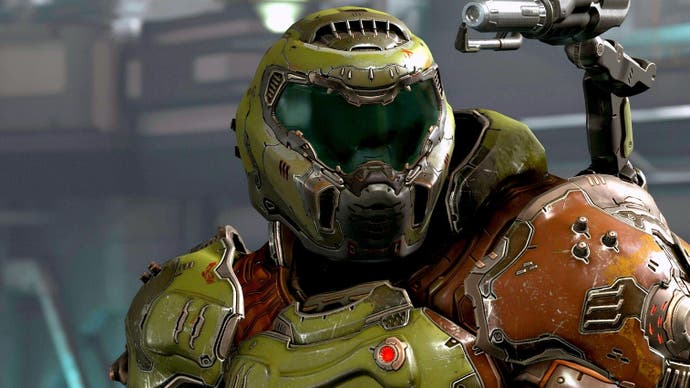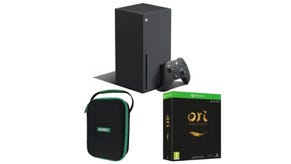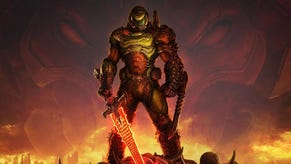Doom Eternal analysis: how id Tech 7 pushes current-gen consoles to the limit
Next-level technology and brilliant design produce one of the best shooters of the generation.
Doom 2016 revitalised the fortunes of both id software and the classic Doom franchise, delivering a phenomenal, exhilarating focus on high-speed combat, extreme gore and sprawling stage design. It was a modern, refreshed take on a retro classic, underpinned by some of the most impressive tech in the business. And the good news is that Doom Eternal one-ups it in every way. it's harder, faster and sleeker. It's larger in scale both in terms of level design and the amount of enemies you'll battle - and it's more optimal too: we've managed to get the PC version running at around 300 to 500 frames per second.
Powered by the new id Tech 7, Doom Eternal represents the latest and greatest from id Software, delivering an engine upgrade that delivers in every way. Textures are more detailed all around while the world is more tightly packed with visual flourishes. Even if you can't put your finger on it right away, there's something special about the environments that just feels >different. How is it that a game on the same consoles can look and run so much better than a previous installment?
The answer is not so simple but the basic idea is - it comes down to key changes made to the internal technologies. Having discussed id Tech 7 with lead engine programmer Billy Khan, he reiterated that their main objective was to deliver a combination of visuals and frame-rate at a quality so high that most people will wonder how it was possible.
One of the first major shifts is the move to the low level Vulkan graphics API - not just for in-game rendering on the PC side, but for everything including the backend tools used to build the game. Vulkan enables faster performance within the id studio, enabling the creators to work faster and more efficiently. Assets can be created and implemented at a much higher rate than the previous game. This is evident in the variety on display - Doom Eternal takes players to many different places. From ruined cities to space colonies and other dimensions and beyond, the world is constantly changing. This new releases features upwards of ten times the number of unique assets when compared to the previous game - all with a big bump to detail.
A large part of this increased level of detail stems from the shift away from id's legacy megatexture technology. Originally created for Rage, megatextures were designed to allow increased variety by storing texture data in a large texture atlas that could be referenced based on what was needed on-screen at any moment. Streaming texture data in and out made sense on a platform like PlayStation 3 with limited memory but it didn't scale well and has a lot of limitations. Disk space requirements were huge, iterating on textures required a lot of time and quality was compromised by multiple steps of compression. Even on fast PCs, texture pop-in remained an issue in Doom 2016.
For id Tech 7, the team has crafted a high performance image streaming solution instead, meaning much higher resolution textures. The move away from megatextures means that artists can more quickly make changes, combine layers and generally build more interesting assets without the same drawbacks as id Tech 6. There's added flexibility too. The geometry decal system which has been expanded to allow artists to direct place decals directly on models during asset creation. These decals can be moved around wherever the artist wants allowing for increased experimentation and efficiency. The key here is that artists can create all these different materials then simply paint over the surfaces to create the desired look.
Another element in pushing forward detail lies in geometry. Doom Eternal features dramatically more complex scenes with an average of 8 to 10 times more triangles per scene. Laid out raw, you might have as many as 80 to 90 million triangles in view. Today's current-gen machines would likely buckle under this load which is where the new triangle and occlusion culling system comes into play. Basically, the CPU determines which surfaces aren't needed during rendering and rejects them. A small software buffer (which is basically a small texture created every frame) tells the game which surfaces are occluded and this info is sent to the GPU. This helps the game draw only the visible triangles each frame and its efficiency allows the team to utilise higher density meshes to build the world.
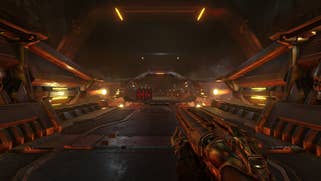
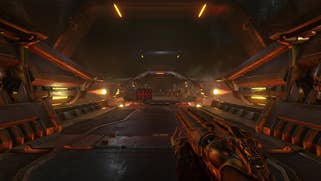
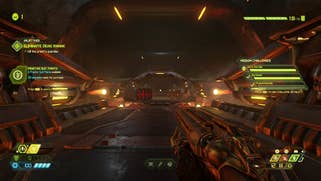

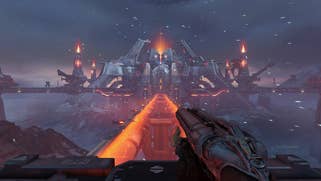
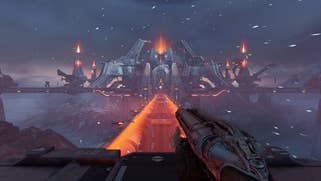
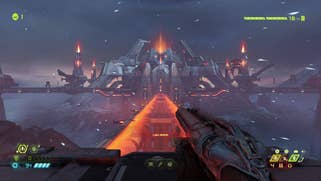
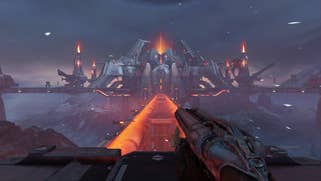
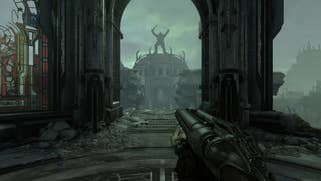
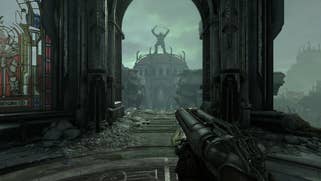
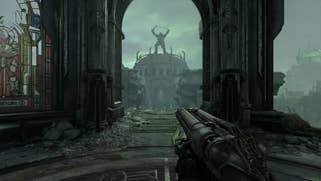

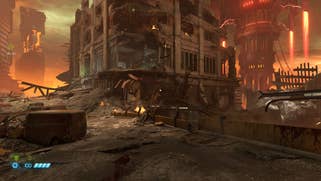
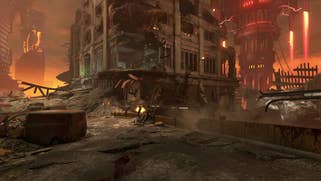

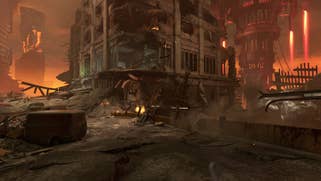
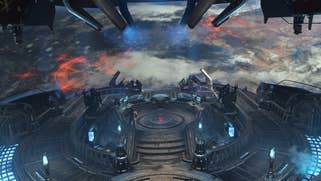
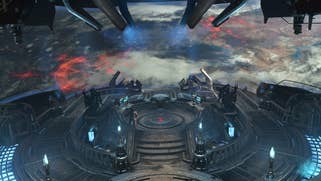
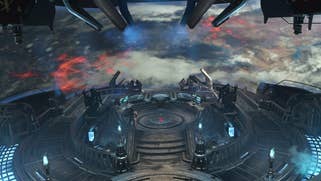

This is coupled with a new LOD system that is designed to effectively switch between detail levels on models without interrupting the presentation. This works by determining how much of screen-space an object occupies on-screen at a per pixel level, then using the factor generated to decide uniformly when to switch LODs. There's also a new light culling system which allows for per-pixel depth information to be read on each light. By rejecting unnecessary pixels per-light, designers have more flexibility in terms of how many lights per scene can be utilised. That means more dynamic and point lights in every stage. Ultimately, a lot of focus has been poured into more aggressively managing what does and does not appear on screen. These techniques are a key part of optimisation and a big part of why Doom Eternal can throw around much more detail per scene.
Other features are entirely revamped too - such as the gore system. Each model is comprised of multiple geometry layers smashed together. The idea is that you can dynamically clip chunks of the model apart revealing layers below the primary surface - perfect when it comes to chainsawing enemies to pieces. Everything is built around unified rigs that are designed to be easy to edit, enabling faster content creation and more creative dismemberment. There's also an improved blood splatter system that is combined with the destructible demo system. This all works in tandem to create enemies that feel more like fleshy beings as opposed to static models. Your weapon has a genuine impact on enemies as you engage in combat making it feel as if you're doing real damage.
Id Tech 7 also supports Alembic animation caching - a technique pioneered by Industrial Light and Magic almost ten years ago. This enables complex, reusable animations to playback effortlessly in real-time allowing more nuanced animations and events. We've seen this before in games such as Gears 5 but Doom Eternal utilises it everywhere - and to spectacular effect in some of the game's impressive real-time set-pieces. It's impressive at the macro scale - but also on the micro scale too. Alembic animation is used all over the game: writhing tentacles and demonic bits pulsate realistic, for instance, and this is done using Alembic. All of this data is streamed as needed but relatively light on resources, but the effective is transformative - the world is constantly animated.
The cumulative effect of all of these technologies is simply stunning. Each stage in the game is larger than anything in Doom 2016 while offering more geometry, higher resolution materials, additional animation and a wealth of dynamic lights. It's also packed with more variety on top of that. For my money, it's one of the best-looking games ever made - and the good news is that the experience is brilliant on all systems. Obviously, some sacrifices are made as not all platforms are created equally, but there are no 'bad' ports here. In terms of image quality, id has taken great care to ensure minimal aliasing across the board. The mix of TAA and temporal upsampling enables a clean image on all machines, even when the base pixel count is rather low. The major differentiating factor is clarity.
At the top of the stack we have Xbox One X which tops out at 1800p, while PS4 Pro comes in with a maximum resolution of 1440p. The vanilla PS4 is maxes out at 1080p and Xbox One S hits a high of 900p. In all cases, dynamic resolution scaling is implemented to ensure consistent performance. Xbox One X takes pole position here with a resolution that seems to stay above 1440p even in busy scenes, dropping to 1080p or maybe slightly below in the busiest scenes. Both base consoles can drop to near 720p, though PS4 never quite drops that low. Of the four, the base Xbox One is the only version that regularly appears blurry during normal gameplay, but at least aliasing is kept to a minimum across all platforms. Image quality is fantastic, all things considered.
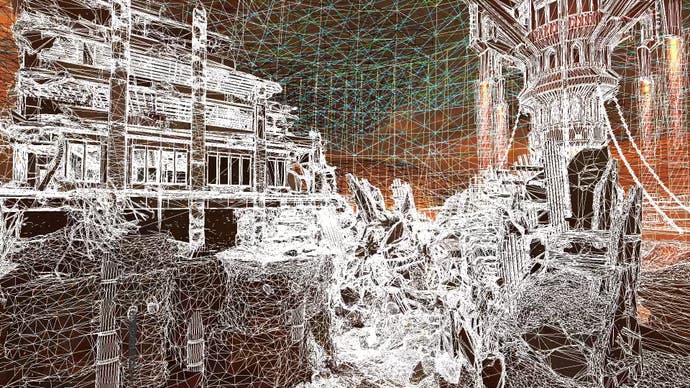
Beyond resolution, settings also differ per platform. The base systems offer detail levels consistent with the PC version set to medium while Xbox One X and PS4 Pro use a mix of high and ultra settings. One of the primary optimisations relates to LOD distance - the point where the game swaps between higher and lower detail models based on distance from the camera. LOD is related to pixel count, so the base consoles routinely use lower detail LODs, but because it's tied to resolution, there's little in the way of noticeable object pop-in - it feels stable on all platforms. Only when you compare the vanilla machines with PS4 Pro or Xbox One X do you notice the difference.
Beyond the basic settings, however, the visual quality is comparable overall. Most effects are consistent across the board - the full suite of post-processing is utilised everywhere and the game looks great in all cases. Performance is also impressive, with a nigh-on locked 60fps on the enhanced machines, marred only by what seem to be occasional hiccups in I/O - which curiously manifested more noticeably on Xbox One X. However, the real takeaway here is that performance is so much more consistent than Doom 2016, despite the huge increase in fidelity across the board.
Neither PlayStation 4 nor Xbox One S deliver quite the same level of stability as the enhanced consoles but they're not that far off. On PS4, for instance, the minor dips in frame-rate are simply a little more frequent, but ultimately this is a rather minor issue. Xbox One S is a similar story but here, the dips are even more pronounced. Given the relative lack of power in this system, however, the results are impressive and if you own the S, I can still strongly recommend the game. All of which is to say that I feel the team met its 60fps goal. Doom Eternal is more stable than Wolfenstein 2 from Machine Games and even smoother than Doom 2016. It just looks and plays nicely on all platforms.

Of course, the PC version is the way to go if you have the hardware as it supports much higher frame-rates all around. I'm running a rather powerful rig equipped with a 16-core Intel i9 7960X and an RTX 2080 Tiso you'd expect greater performance and it's delivered without issue. In the marketing push up to launch, id promised astonishing performance and the team has delivered. In-game performance varied between 300 to 500 frames per second and Doom Eternal becomes one of the very few triple-A games that can actually deliver sustained, consistent performance for high refresh rate screens - up to and including the latest 360Hz displays.
So, the game is fast, optimal and beautiful - and one of the most impressive looking titles I've ever played. The mix of performance and detail is just perfect but it's not just a pretty face - there's a lot more to Doom Eternal beyond its technology. It's simply a terrific game. At its core, between the colorful visuals, anti-gravity antics and fast pace, it feels like a mix of Doom and Quake 3 Arena in single-player form. Levels are designed around light exploration with secrets and keycards to find but combat is still the primary focus. There is much more in the way of platforming and aerial combat this time. Jump pads, climbing surfaces and huge open areas specifically recall some of the crazier Quake 3 maps while the grappling hook on the super shotgun becomes one of the most enjoyable weapons in the game, serving as a slingshot of sorts.
With Doom Eternal, I feel that id has made a clear distinction between new Doom and classic Doom - and that's great. The original still holds up but I appreciate the way in which Eternal builds on some of those concepts while breaking new ground. It respects the past without being beholden to it - Doom Eternal is very much its own game. And that's why I feel it's an essential purchase. It's a lengthy single-player adventure packed with interesting stages, enjoyable combat and brilliant presentation. Put simply, I can't recommend it enough. Without question, Doom Eternal is one of the best action games of the generation.
